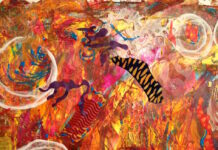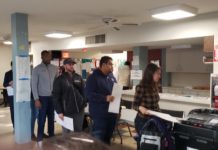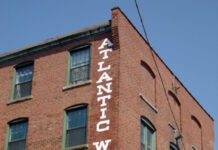by FRANK CONTE
It’s not everyday that artists wake up and find their work trashed, altered or stolen. But when you are a Reclamation Artist working on neglected public land for all the world to see, vandalism goes with the territory.
“Nobody sees it as a surprise,” says John Powell a light artist and sculptor who organized Site 8, an unique outdoor exhibit in the hopelessly neglected Boston East site on Border Street. “The site is occupied in a sense and we’re on their turf.”
Their turf. The turf of nomads, of kids –excuse the pun –possibly painting the town red, getting a kick out of trashing trash.
Powell is referring to the Reclamation Artists most recent installation at the Boston East site on Border Street. The exhibit, not the kind of thing you usually find in East Boston, disassembled into memory when it closed last June 18. For almost a full moth, works recalling the glory of 19th century ship building and immigration graced the grassy vacant Border Street lot often frequented by vagrants.
Just two weeks ago into this novel exhibition, some artists found parts of their work demolished. The culprits have not been found. And they never will be.
But that didn’t dampen the spirits of artists or the community that’s welcomed them into East Boston. In fact, the recent spate of vandalism seems to add another dimension to the urban art. It’s what happens when squatters vie for space. And that suits the group just fine says Powell. Nothing wrong with a little urban drama; you don’t find that on pretentiously glib Newbury Street.
Reclamation Artists is a five-year-old ensemble of local artists who “invade” and convert abandoned lots into public art spaces. Since its inception, the group has established sites at the proposed Scheme Z interchange and the now-demolished Rapid Service Press property alongside the Southeast Expressway.
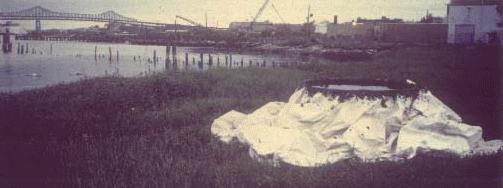
The reclamation movement is not new. Drawing its lineage back to the French Revolution, reclamation art is well-known in big cities such as New York, Atlanta and Los Angeles.
“It calls attention to the political situation of under-used land and the city’s role and the various communities’ role in maintaining the land and making the land available for people to use,” explains Jane Hans, whose own contribution, “Shelters”, little model-like houses, recalls the memories of voyagers on long sea journeys.
The artists are clearly drawn by East Boston’s rich maritime history and the neighborhood’s last remaining parcel of land available for development. Last known by longtime residents as the site of a naval infirmary, and today bound by tug boat yard and a shopping plaza, Boston East has proved literally to be fertile ground for the artistic imagination. Site 8 didn’t disappoint.
“I think it’s one of the best sites we’ve done,” says Powell, who spent most of the Saturday nights during the exhibit lighting up the East Boston waterfront with a sodium vapor light “It has an unbelievable presence. It’s really beautiful and it has an incredible amount of material.”
In addition to imagination, most of the work is made from material — some of it junk — found on Boston East. Other materials, such as the copper nails once used to hold boat frames together, come by way of Daniele Erville who is excavating a modest archeological dig for Site 8. Erville had the benefit of some free labor, local kids with no hangup about fighting turf battles.
Working from old fire insurance maps, Erville discovered the dominance of ship building in East Boston where locals streets were filled with blacksmiths and foundries.
Those were the days when the launching of a clippership held an entire community in awe. “When the biggest ship was ready to be launched, they closed the entire town so that everyone could see,” says Erville. “That reminded me a lot of people today watching the space shuttle.”

That same kind of optimism may be rekindled again. Both the Boston Redevelopment Authority and the Massachusetts Port Authority will soon wind up a seven-month study of the harbor’s role in a global economy. In the early months of 1995, the East Boston Land Use Advisory Council established a subcommittee as a sounding board for ideas. And last May, the city chose East Boston as one of the recipients of a Main Streets Initiative grant that hopes to increase business activity along a bustling corridor not far from Boston East.
In this rebirth of East Boston, Reclamation Artists are adding a rich cultural contribution to go hand in hand with economic development.
“It all adds up to what East Boston is trying to do: to draw positive attention to East Boston,” says Russell Tryder, vice president of the non-profit Shining Sea Foundation. The foundation, no stranger to Boston East, has been trying to raise funds to build a 20th century version of the clipper ship made famous by East Boston’s own Donald McKay. Tryder helped Powell and his merry crew set up shop, no too far from where McKay was thinking about his faster and smarter clipper ships.
The artists’ interpretation of that history is welcomed, says Tryder. As well as statements about the future.
Long enthralled by the urban landscape, Bill Harby, a Belmont artist who collaborates with sculptor Bill Martin, found use for two sofas dumped on the Border Street lot. Entitled, “Room with a View”, Harby’s installation offers a window to an underrated harbor view of Charlestown and the Tobin Bridge. Ironically, the original two sofas found on the site were stolen and Harby found a quick replacement in the Want Advertiser. He now locks the couch to the platform. This proves a point, says Harby.
“If you take junk and put it on a platform and do something like wrap it with mylar then all of a sudden it becomes preciousand somebody wants it,” he explains.
“And in the same way with the site here — these broken down piers and wrecked shipyards — we’re trying to say this is a wonderful place just by the fact we come here trying to make art.”
Site No. 8 is not without sound. As artists described their work on a beautiful Saturday afternoon recently, an itinerant visitor, Freddie, provided ambiance as he drank and cheered the Red Sox on his Walkman.
Just as subtle and harmonious is a work that captures the sound of the wind so important to clipper ships.”Derelict Gate & Found Objects,” by South End artists Wendy Ingram and Cary Wasserman, is a wind chime made from fencing, cans, broken glass and tin. “Some of the metals were older pieces that actually held the framework of the marine railway together,” she said. Ingram says residents from East Boston are impressed with the work. “Some of the people living in the neighborhood really like the idea of doing something positive because I guess in the past they said this used to be a dump.”
Other than a dump, the Boston East was also a prime location for the climatic bomb explosion in the 1993 MGM movie, “Blown Away” with Jeff Bridges and Tommy Lee Jones. While many looked on at the spectacular and fiery explosion which destroyed an old ship, residents and local businesses were distressed that promises to pay for damages to local stores were not kept.
In contrast, the artists’ enthusiasm seems to convey a optimism and pride to residents. “It’s going to put us on the map,” said Edith DeAngelis, the long- time activist and local expert on open space. “It looks like people on the outside are beginning to take notice,” she added.
What the artists are also taking notice of is the neighborhood’s rich history, the foundation of Muriel Angelil’s work. Angelil’s installation, “Homage to Columbus and Whosoever Came Before or After”, is a literal telltale tribute to immigration long connected to East Boston, where thousands of Irish, Italian and Polish found themselves before checking into Ellis Island in New York.
The piece consists of a clothesline with fabric strips bearing the names of immigrants found on ship logs from 1900 to 1920. Next to it, is a list of questions asked by immigration officials that would reach beyond the pale, such as “Are you a polygamist?” “Are you able to read or write?” “What’s the condition of your health, mental and physical?” “Are you are anarchist?”
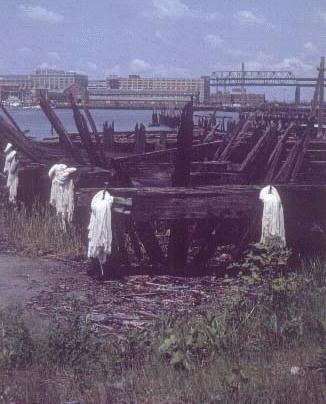
Artist Leslie Wilcox calls the Boston East Site a dynamic environment for which to create. Wilcox has recently shown work on Newbury Street as part of the “Off the Wall: What a Relief”, curated by Charles Giuliano , the art critic and local resident. Her work at Boston East, which uses decaying timber found nearby, is the closest direct representation of the old shipyard, staged near marine tracks where maiden voyages were launched. From afar, “Ship Shaped” and its three-dimensional skeleton of a mock s hip draped in part by black screen, haunts Site 8. Wilcox said “Ship Shaped” is a metaphor for the demise of a once-thriving shipbuilding industry in East Boston, where wooden clipper ships were soon to be replaced by steam engines. Her narrative lends itself to nordic ritual.
“What the Vikings used to do is take the ships and put their dead in them,” she notes explaining the details of her work. “And this is how they would shroud them over with a black cloth or hard fabric before sending it out to sea. For me it’s a marker or memorial.”
Don’t expect any of the Site 8 pieces to show up in a gallery any time soon. Keeping in line with the tenets of the reclamation art movement, all pieces and their parts are dissassembled and left in the state in which they were found.
Which goes to show that a group of motley artists can leave Boston East in better shape than a multi-million dollar movie maker.
This article first appeared on www.eastboston.com in 1999. All rights reserved. Photography courtesy John Powell (RIP), Reclamation Artists.



